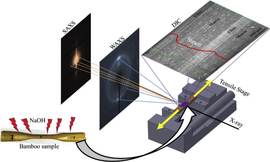 |
Date Announced: 27 Feb 2020
Bamboo, with its unique material properties and wide range of applications, has been the subject of many theoretical and experimental studies. Bamboo possesses exceptional flexural strength, due to its hierarchical structure, which is functionally graded and naturally optimised across its stem. To modify its properties, bamboo is commonly treated with Alkaline solutions, such as Sodium Hydroxide (NaOH). These treatments allow the material properties to be modified, allowing transforming it into e.g. soft textiles, and/or its fibres extracted and used in composites, or as fuel.
In a recent study at Oxford’s Multi-Beam Lab for Engineering Microscopy (MBLEM), headed by Prof Alexander M. Korsunsky, a team of researchers working with Dr Enrico Salvati carried out a series of in situ tensile tests using the Deben UK Ltd MT5000 micro-tensile stage in order to investigate and elucidate the effects of NaOH treatment on the elastic behaviour of bamboo. The specimens were prepared from mature Bambusa Glaucescens or ‘Golden Goddess’ bamboo, with consistency and uniformity of the samples assured by adopting a strict preparation protocol. Specimens were treated with various concentrations of NaOH for approximately 20 minutes under ambient pressure and temperature conditions. In situ mechanical testing was carried out on beamline B16 at Diamond Light Source, the UK synchrotron facility. Small and Wide-Angle X-ray Scattering (SAXS and WAXS) were used, in combination with optical microscopy and Digital image Correlation for deformation analysis. This allowed monitoring and evaluating material structure evolution during deformation, and linking it to the observed mechanical response. A schematic diagram of the experimental set up is shown in Figure 1.
The results indicate that up to 20% NaOH the elasticity of the fibres exhibited a steady increase and when compared to the original material were 59% stiffer. However, at higher concentrations the fibre elasticity was reduced by 37% compared to the original material. It is reasonable to suggest that higher concentrations of NaOH disrupt fibril bonding, reducing adhesion between fibrils and thus significantly reducing the overall stiffness and toughness of the bamboo.
In summary, it can be concluded that the combination of techniques utilised in this research has provided detailed insight into the elastic properties of the bamboo fibres and their variation due to NaOH solution treatment. These exciting results provide support for the proposed mechanism of NaOH interaction with bamboo, and provide an excellent basis for further quantitative and precise studies to develop further ‘real-life’ applications of bamboo.
References
E-mail: abigailr@deben.co.uk
Web Site: deben.co.uk
| © 2025 SPIE Europe |
|